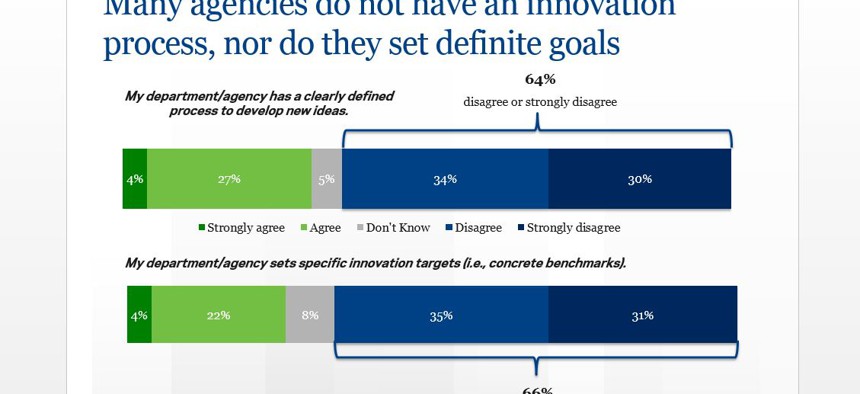Many Agencies Aren't Collecting Data on New Initiatives
Creativity is important for organizations trying to stay agile as they solve problems new and old. So how are agencies encouraging their employees to devise new solutions? Here’s the second post in our Innovation Series, where we’ll walk you through what we found.
Last week, we introduced our Innovation Series, which will explain the findings of GBC’s latest effort to assess the state of creativity in federal agencies. There are myriad reasons for government employees to innovate; our respondents told us that the prospects of reduced costs, expedited mission delivery, increased effectiveness, and a commitment to public service are their main drivers. Less clear, however, are the means by which agencies can support innovation.
Since evidence-based decision making is on the rise in virtually every field, we suspected that it could be a good place to start. Tracking the performance of programs can help managers identify gaps that renewed efforts may help fill. Alternatively, performance data can introduce positive feedback when it demonstrates the effectiveness of new programs, further incentivizing employees to innovate. Although collecting data is generally believed to be a good idea, survey respondents told us that implementation of smarter program monitoring techniques hasn’t really caught on. Just 33 percent of respondents say their agency effectively tracks the performance of new initiatives.
In the absence of clear evidence or feedback for success, how do employees go about sharing and coming up with new ideas? Our respondents suggest that when innovation happens, it’s largely unfocused and unsupervised. When asked the extent to which they agree or disagree that their agency has a process for innovation, 64 percent disagree. Along the same lines, when asked whether their agency sets specific targets or benchmarks for innovation, sixty-six percent disagree.
Our data suggests that without guidelines or supervision, innovative employees may become frustrated with the government environment. Without the required structure, new ideas may never reach their potential, or worse, may be considered sources of unnecessary risk. In our next post, we’ll look at a few things agencies can do to create an environment where new ideas can survive.
Methodology: GBC deployed a survey to a random sample of Government Executive, Nextgov, and Defense One online and print subscribers in August 2014. The pool of respondents includes those of GS-11 through Senior Executive Service levels in at least 30 different civilian and defense agencies. To see the rest of our findings, download the report here and stay tuned for more in our Innovation Series.
This post is written by Government Business Council; it is not written by and does not necessarily reflect the views of Government Executive Media Group's editorial staff. For more information, see our advertising guidelines.






